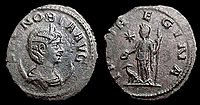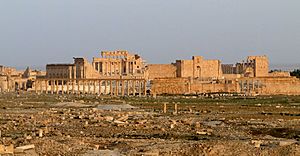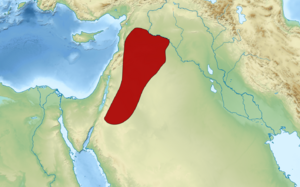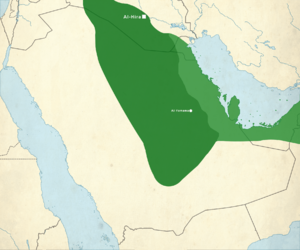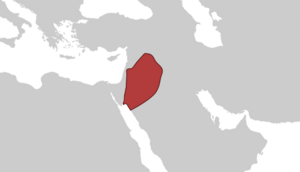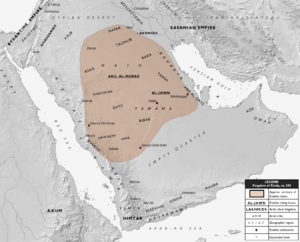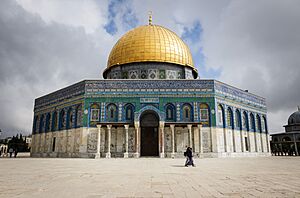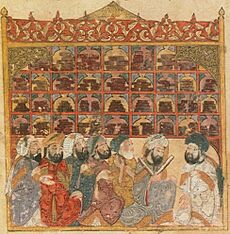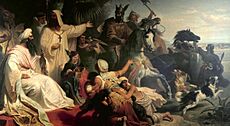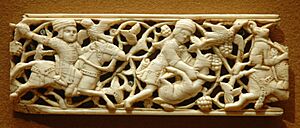History of the Arabs facts for kids
The story of the Arabs goes back a very long time, with the earliest known writings in the Old Arabic language appearing in the mid-9th century BCE. Many people believe that Arabs are descendants of Ishmael, who was the son of Abraham. The first groups of people called "Arabs" lived in the Syrian Desert. Over thousands of years, other Arab groups spread out across the land.
Before the Rashidun Caliphate expanded (from 632 to 661 CE), the word "Arab" described different tribes. These tribes were often nomadic (meaning they moved around a lot) or settled in places like the Arabian Peninsula, the Levant (eastern Mediterranean), and Mesopotamia (modern-day Iraq). Today, "Arab" refers to many people whose home regions make up the Arab world. This happened because Arabs and the Arabic language spread widely during the early Muslim conquests in the 7th and 8th centuries.
The Arabs built huge empires called caliphates: the Rashidun (632–661 CE), Umayyad (661–750 CE), and Abbasid (750–1258 CE). These were some of the largest land empires in history. They stretched from southern France in the west to China in the east, and from Anatolia (modern-day Turkey) in the north to Sudan in the south. In 1517, the Mamluk Sultanate was taken over by the Ottoman Empire, which then ruled much of the Arab world. After World War I, the Ottoman Empire was defeated and broken up. Its lands were divided, creating the modern Arab states we know today. The Arab League was formed in 1945 to help these Arab countries work together.
Contents
Ancient Times
Early Settlers
For a very long time, since about 6000 BCE, people called Bedouins lived in the Syrian steppe. They moved around with their animals (nomadic herding), farmed, and sometimes fished. By 850 BCE, they had created a complex network of villages and camps. The earliest Arab tribes came from these Bedouin groups.
Iron Age Arabs
The first mentions of Arabs appear in ancient texts from the 9th to 5th centuries BCE. These texts, from the Bible and Assyrian records, show Arabs living in parts of the Levant, Mesopotamia, and the Arabia. Many Arab tribes and towns are named in records from the Neo-Assyrian Empire. These tribes were found across Mesopotamia and the Syrian Desert. Often, they lived alongside Aramean tribes. For example, near Terqa, Aramaean and Arab groups joined together.
In 858 BCE, the Assyrian king Shalmaneser III fought against a group that included two Arab leaders from tribes near the Orontes River. Later, in 853 BCE, Arabs were part of a large army from Damascus that fought in the Battle of Qarqar. This army included Syrian and Israelite allies, led by an Arab king named Gindibu. During the reign of Tiglath-Pileser III (744–727 BCE), Arabs were brought into the Assyrian system. They were found in areas like Damascus, Tadmor, and Homs. Tiglath-Pileser III even put an Arab named Idibi'ilu in charge of the Sinai Peninsula. Arab raiders also attacked Sargon II's troops in the Beqaa Valley.
A group called the Nabayatu, who might be the ancestors of the Nabataeans, are mentioned in a Babylonian letter from before 648 BCE. They lived near the Babylonian border. During the wars of Ashurbanipal (669–631 BCE), most Nabayatu groups moved to the Syrian Desert. By the 6th century BCE, they had moved south of Wadi Sirhan. Ashurbanipal also fought against Arabs in Hauran and took their leader, Abiyate the Qedarite, to Assyria.
Classical Arab Kingdoms
Ancient North Arabian texts help us understand how the Arabic language developed. These texts come from Jordan, Saudi Arabia, and Syria. They show early forms of Arabic, like Safaitic and Hismaic, as well as older languages spoken in the Arabian peninsula. These writings use scripts similar to the ancient South Arabian musnad.
The Nabataeans
The Nabataeans were nomadic people who settled in an area left by the Edomites. At first, their writings were in Nabataean Aramaic, but they slowly started writing in their spoken Nabataean Arabic. This gives us some of the earliest clear Arabic texts. The Nabataean alphabet was later used by Arabs further south and eventually became the modern Arabic script around the 4th century CE. This is seen in Safaitic writings (starting in the 1st century BCE) and many Arabic names in Nabataean texts. By the 2nd century BCE, some writings from Qaryat al-Faw show a dialect that is very close to classical Arabic.
Arabs in Syria
Arabs are first mentioned in Palmyra in the late first millennium BCE. Soldiers led by a leader named Zabdibel, who helped the Seleucids in the battle of Raphia (217 BCE), were described as Arabs. Zabdibel likely came from Palmyra. After the Battle of Edessa in 260 CE, the Roman emperor Valerian was captured. The Palmyrenes, led by Odaenathus, then fought for Rome. They defeated the Sassanian armies many times, even reaching their capital city, Ctesiphon.
Odaenathus's son Vaballathus took over in 270 CE, with his mother Zenobia as his regent (meaning she ruled for him). Zenobia declared the Palmyrene Empire and quickly took over most of the Near East, including Egypt and much of Asia Minor in 271 CE. However, Zenobia was defeated by the Roman emperor Aurelian, who was helped by the Tanukhids. The Tanukhids were a group of Arab tribes who first appeared in 196 CE. They roamed the western banks of the Euphrates river and later moved into central and northern Syria. They became allies of the Romans. They even rebelled against Roman rule in 378 CE under their queen, Mavia, who led her forces into Palestine, Arabia, and Egypt. They also served as helpers in the Roman army.
South of the Taurus Mountains and near Antioch, there was an Arab group led by Aziz. He played an important role in the affairs of the last Seleucid king, Antiochus XIII Asiaticus. East of Antioch, another Arab group ruled in Chalcidice. They were led by different Arab princes, including Alchaedamnus, who fought against Tigranes. Another Arab group, the Emesene Arabs, controlled Emesa and Aresutha until the 2nd century CE. They were involved with the later Seleucid kings. Near the Qalamoun Mountains, an Arab group called the Zabadaioi fought against Alexander Jannaeus (103–76 BCE).
The Itureans, another Arab group known since the time of Alexander the Great, lived in the Bekaa valley, Southern Lebanon, and the Anti-Lebanon Mountains. From there, they expanded their lands to the Phoenician coast and areas near Damascus. In southern Palestine, the Idumaeans lived and became numerous west of the Dead Sea. Their names were a mix of Arabic and Canaanite names. Arabs also lived in Egypt even before Christianity spread, in areas like Arabia, Arsinoites, and Thebaid.
Arabs in Mesopotamia
Further north, the Osroeni Arabs controlled the city of Edessa from the 2nd century BCE until the 3rd century CE. The Kingdom of Hatra was also ruled by an Arab family from the 2nd century CE. Their rulers often used the title malka (king) or "King of the Arabs." The Osroeni and Hatrans were part of several Arab groups in northern Mesopotamia. This strong Arab presence in northern Mesopotamia was recognized by the Sasanians, who called the region Arbayistan, meaning "land of the Arabs."
Later Arab Kingdoms
Several Arab kingdoms and groups of tribes grew powerful during the middle and late ancient times. They controlled large areas in the Arabian Peninsula, the Levant, and Mesopotamia.
In central Arabia and Iraq, the Lakhmids took over from the Tanukhids. By 300 CE, they became allies of the Sasanians, ruling from their capital city of Al-Hirah. They acted as a barrier between the Sasanians and the Romans, and also against unruly nomadic Arab tribes further south. The Ghassanids served a similar purpose for the Byzantines after they settled in Syria around 250-300 CE. The Ghassanids were part of a large movement of people from Yemen due to conflicts there. When they settled in the Levant around 300 CE, the Ghassanids also became allies of the Romans, along with other Arab tribes like Banu Amilah and Banu Judham.
The Greeks and Romans called all the nomadic people of the desert in the Near East "Arabi." The Romans called Yemen "Arabia Felix" (Happy Arabia). They called the allied nomadic states within the Roman Empire Arabia Petraea, named after the city of Petra. They called the unconquered deserts bordering the empire to the south and east Arabia Magna (Great Arabia).
The Kingdom of Kinda was another Arab kingdom in central Arabia. It was formed around 450 CE as a group of Ma'ad tribes ruled by the Kindites. The Kindites originally came from Yemen with the Ghassanids. They had helped the armies of the Sabaean and Himyarite kings. They returned to Yemen and allied with the Himyarites, who helped them set up a kingdom in Central Arabia.
The Lakhmids fought with the Kindites for control of the Central Arabian tribes. The Lakhmids eventually destroyed Kinda in 540 CE after their main ally, Himyar, fell. The Persian Sassanids ended the Lakhmid dynasty in 602 CE.
Medieval Times

Rashidun Caliphate (632–661 CE)
After the death of Muhammad in 632 CE, Arabs were united by their new faith. The Rashidun armies began to conquer surrounding lands controlled by the Sassanians and Romans. This led to the creation of the Rashidun Caliphate. The capital of this new state was first in Medina (from 632 to 656 CE) in the Hejaz region. Later, Ali moved the capital to Kufa.
Umayyad Caliphate (661–750 CE)
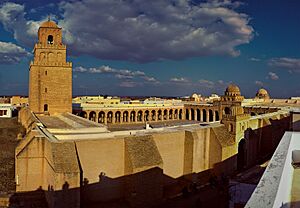

In 661 CE, the Umayyad family took control of the Caliphate and made Damascus their capital. The Umayyads mainly used Arab soldiers from Syria and supported poetry. They built military towns in places like Ramla, Raqqa, Basra, Kufa, Mosul, and Samarra. These towns grew into important cities.
The Caliph Abd al-Malik made Arabic the official language of the Caliphate in 686 CE. This change greatly influenced non-Arab peoples and helped spread the Arabic language throughout the region. However, Arabs had a higher status than non-Arab Muslims, and non-Arabs had to pay higher taxes. This caused unhappiness. Caliph Umar II tried to fix this in 717 CE, saying all Muslims should be treated equally. But he died after only three years, and his changes didn't fully happen. People became more and more unhappy with the Umayyads, leading to an uprising. The Abbasids then came to power and moved the capital to Baghdad.
The Umayyads expanded their empire westward, taking North Africa from the Byzantines. Before the Arab conquest, North Africa had been settled by different groups, including Berbers, Punics, Vandals, and Romans. After the Abbasid Revolution, the Umayyads lost most of their lands, except for Spain (Iberia). This last part became known as the Emirate of Córdoba. Later, it became the Caliphate of Córdoba. This new state saw a lot of growth in trade, culture, and knowledge. Beautiful buildings were constructed, and the library of Al-Ḥakam II had over 400,000 books! When the Umayyad state in Spain fell in 1031 CE, Islamic Spain broke into many smaller kingdoms.
Abbasid Caliphate (750–1258 CE)
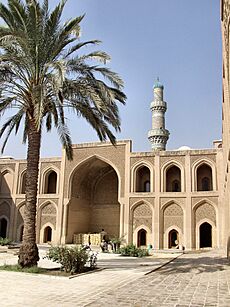
The Abbasids were descendants of Abbas ibn Abd al-Muttalib, who was one of Muhammad's youngest uncles. The Abbasids led a revolt against the Umayyads and defeated them in the Battle of the Zab. This ended Umayyad rule everywhere except Spain. In 762 CE, the second Abbasid Caliph al-Mansur founded the city of Baghdad and made it the capital. Unlike the Umayyads, the Abbasids had the support of non-Arab people.
The Islamic Golden Age began in the mid-8th century when the Abbasid Caliphate rose to power and moved the capital to Baghdad. The Abbasids were inspired by Islamic teachings that valued knowledge, like the saying, "The ink of the scholar is more holy than the blood of martyrs." During this time, the Muslim world became a center for science, philosophy, medicine, and education. The Abbasids supported learning and built the "House of Wisdom" (Arabic: بيت الحكمة) in Baghdad. Other powerful groups, like the Fatimids in Egypt and the Umayyads in Spain, also created important intellectual centers in cities like Cairo and Córdoba.
The Abbasids ruled strongly for about 200 years. After that, their central control weakened as different regions started to break away in the 10th century. However, their power saw a comeback in the late 1100s. This revival ended when the Mongols conquered Baghdad in 1258 CE and killed the Caliph Al-Musta'sim. Some members of the Abbasid royal family escaped to Cairo. There, the Mamluk generals held political power, while the Abbasid Caliphs continued to support science, arts, and literature.
Fatimid Caliphate (909–1171 CE)
The Fatimid caliphate was started by al-Mahdi Billah in the early 10th century. He was a descendant of Fatimah, who was the daughter of Muhammad. Egypt became the main political, cultural, and religious center of the Fatimid empire. The Fatimid state began among the Kutama Berbers in Algeria in 909 CE. In 921 CE, the Fatimids made the Tunisian city of Mahdia their new capital. In 969 CE, they conquered Egypt and made Cairo the capital of their caliphate.
During the Fatimid period, intellectual life in Egypt was very active. Many scholars lived in or came to Egypt, and there were many books available. Fatimid Caliphs gave important positions to scholars, encouraged students, and built libraries in their palaces. This helped scholars learn more and build on the work of those who came before them. The Fatimids were also known for their beautiful art. Many examples of Fatimid architecture can still be seen in Cairo today, like the Al-Hakim Mosque and the Al-Azhar University.
It wasn't until the 11th century that a large number of ethnic Arabs moved into the Maghreb (North Africa). Starting then, the Arab Bedouin Banu Hilal tribes migrated westward. The Fatimids sent them to punish the Berber Zirids for leaving their beliefs. The Banu Hilal quickly defeated the Zirids and weakened the nearby Hammadids. Some historians believe their arrival was a big reason why the Arabic language and culture spread so much in the Maghreb.
Under the Ottoman Empire (1517–1918)
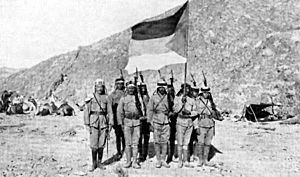
From 1517 to 1918, much of the Arab world was ruled by the Turkish Ottoman Empire. The Ottomans defeated the Mamluk Sultanate in Cairo and ended the Abbasid Caliphate. Arabs didn't feel a huge change in how they were governed because the Ottomans used similar systems to the earlier Arab administrations.
In 1911, Arab thinkers and politicians from across the Levant formed a small Arab nationalist group called al-Fatat in Paris. Their goal was to "raise the level of the Arab nation to the level of modern nations." At first, al-Fatat wanted more self-rule within the Ottoman Empire, not full independence. They held the Arab Congress of 1913 in Paris to discuss desired changes with other unhappy Arabs. However, as the Ottoman authorities cracked down on the group, al-Fatat went underground and began to demand complete independence and unity for the Arab regions.
After World War I, the British Empire overthrew the Ottoman Empire. The former Ottoman lands were then divided between the British and French as League of Nations mandates, which meant they would temporarily govern these areas.
Modern Times
Today, most Arabs live in the Arab world, which includes 22 countries in the Middle East, North Africa, and parts of the Horn of Africa. All of these are modern countries that became important political entities. There is also a large Arab diaspora (people living outside their homeland) around the world, especially after the fall of the Ottoman Empire.
In 1948, Britain left Palestine. The war that followed, known as the Arab-Israeli War, caused nearly one million Arabs to flee to nearby countries. Palestinians call the events of 1948 the Nakba, which means "catastrophe." To this day, millions of Palestinians are still displaced from their homes and cannot return. After this war and later conflicts, most Jewish people in the Arab world moved to Israel. There were more wars between Arab countries and Israel in 1956, 1967, 1967-1970, 1973, 1982, and 2006.
On March 22, 1945, the Arab League was founded in Cairo. It started with six member countries and now has 21. Its main goal is to encourage cooperation among its members.
Many Arab countries depend a lot on exporting oil to power their economies. Iran, Iraq, Kuwait, Saudi Arabia, and Venezuela founded OPEC (Organization of the Petroleum Exporting Countries) in Baghdad on September 14, 1960. OPEC stopped exporting oil to America after the 1973 Yom Kippur War to try and make America stop supporting Israel. The large amount of oil in Arab countries has sometimes led to conflicts and made it harder for these countries to have different types of economies. Some economists call this the "paradox of plenty" – when having a lot of one resource can actually cause problems.
During the Cold War, the Arab world became a place where the West (led by the US) and the East (led by the Soviet Union) competed for influence. Both sides supported different groups and sent troops into various conflicts. For example, the UK set up the Central Treaty Organization in 1955, which was like NATO for the Middle East, but it was later dissolved in 1979.
In 2011, the Arab Spring began in Tunisia and quickly spread across the Arab world. During this time, many Arab countries experienced protests and revolutions aiming for more democracy against their governments. This led to conflicts like the Syrian civil war.
In modern times, about 50 million people of Arab descent live outside the Arab world, forming a large Arab diaspora.


